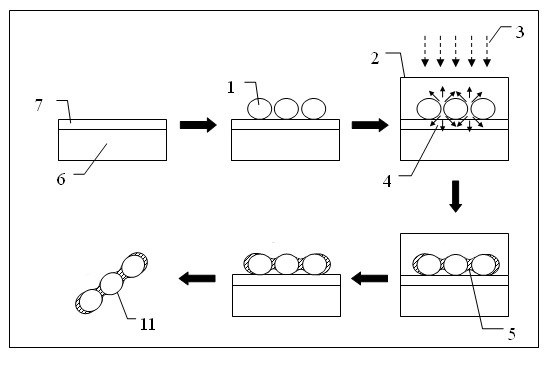Nano-linking method based on photo-curing with nonlinear frequency shift effect
A nonlinear, photocurable technology, applied in the field of photocurable nanolinks that break through the diffraction limit of traditional optics
- Summary
- Abstract
- Description
- Claims
- Application Information
AI Technical Summary
Problems solved by technology
Method used
Image
Examples
Embodiment 1
[0033] Prepare a self-assembled nanoparticle microstructure on the surface of a solid substrate, and apply the nanolink method proposed by the present invention to link nanoparticles. The specific preparation process steps are as follows Figure three Shown:
[0034] Step 1: prepare an organic polymer film 7 on the surface of the solid substrate 6 .
[0035] Step 2: Deposit nanoparticles 1 with surface plasmon resonance properties on the surface of organic polymer 7 through chemical self-assembly technology. The distance between nanoparticles 1 can be controlled by self-assembly technology. In order to achieve effective links, the distance is generally between zero and between tens of nanometers.
[0036] Step 3: drop-coat or spin-coat the UV-sensitive polymer 2 on the surface of the substrate, and irradiate the sample with a low-frequency visible light or near-infrared light source. The incident light forms a significant local light scattering enhancement between the nanopa...
Embodiment 2
[0041] The nano-linkage method proposed by the present invention is used to directly realize the linking of nanoparticles in the ultraviolet photosensitive polymer 2 solution. Specific steps include:
[0042] Step 1: Using an optical method, a high concentration of nanoparticles 1 with surface plasmon resonance properties is doped into a solution of an ultraviolet photosensitive polymer 2 .
[0043] Step 2: Add chemical substances to the UV-sensitive polymer 2 solution, wrap them on the surface of the nanoparticles 1, form a stable chemical coordination bond, and make the nanoparticles 1 form a dynamic self-assembly in the solution, and the distance between the nanoparticles is between zero and between tens of nanometers.
[0044] Step 3: irradiating the UV photosensitive polymer 2 solution with a low-frequency visible light or a light source in the near-infrared band. The incident light forms a significant local light scattering enhancement between the dynamically self-asse...
PUM
 Login to View More
Login to View More Abstract
Description
Claims
Application Information
 Login to View More
Login to View More - R&D
- Intellectual Property
- Life Sciences
- Materials
- Tech Scout
- Unparalleled Data Quality
- Higher Quality Content
- 60% Fewer Hallucinations
Browse by: Latest US Patents, China's latest patents, Technical Efficacy Thesaurus, Application Domain, Technology Topic, Popular Technical Reports.
© 2025 PatSnap. All rights reserved.Legal|Privacy policy|Modern Slavery Act Transparency Statement|Sitemap|About US| Contact US: help@patsnap.com



